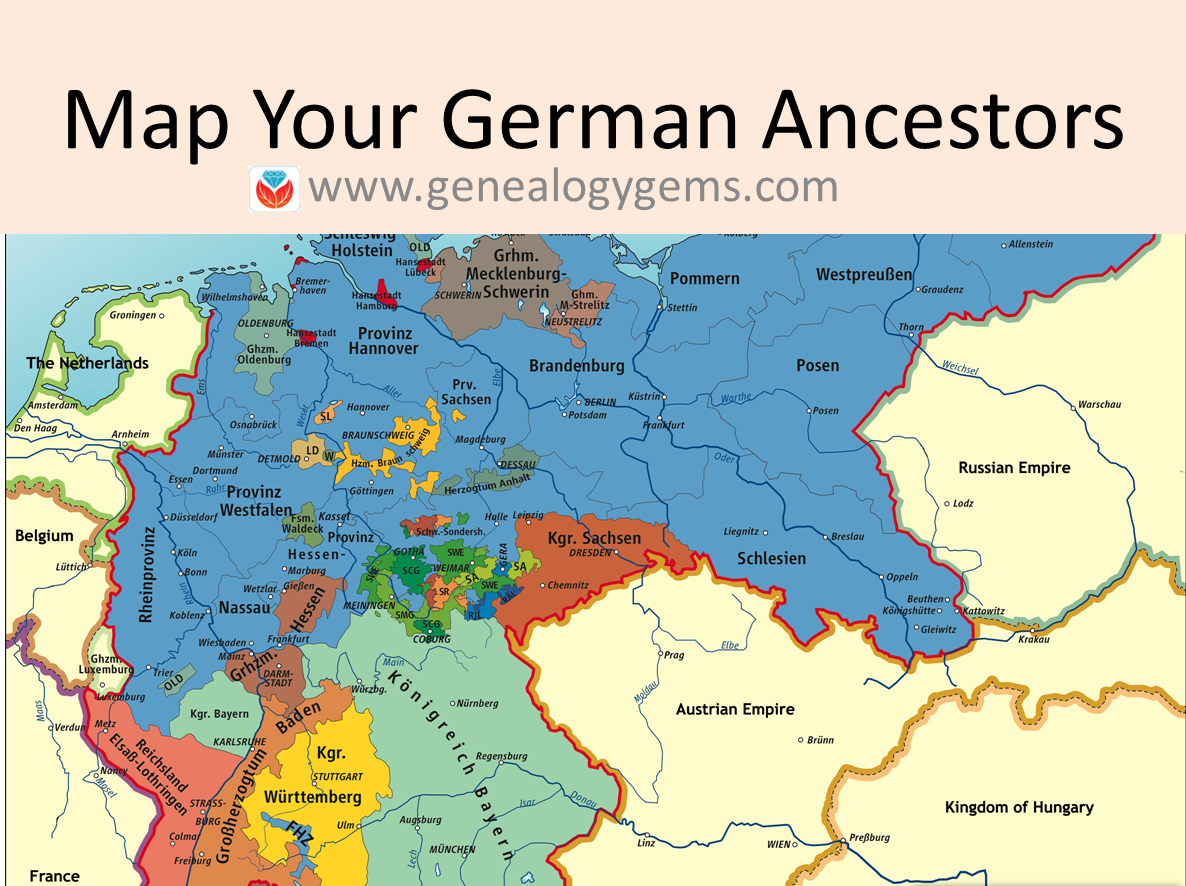3 Free German Genealogy Websites: Maps of Germany and Poland
Finding German hometowns can be challenging. Guest blogger Camille Andrus, a professional genealogist specializing in German research and Project Manager at Legacy Tree Genealogists shares 3 free German genealogy websites to put your ancestors on the map in the former German empire and modern-day Poland.
Anyone tracing German ancestors quickly finds themselves puzzling over maps in a region that has experienced a lot of change. Camille Andrus of Legacy Tree Genealogists recommends these 3 free German genealogy websites to help you navigate the former German empire–from Pomerania to Prussia to Poland. Here are her picks and her explanations for using them.
“For years, novice genealogists who found themselves embarking on the road of German genealogy were discouraged when needing to decipher an entry for their town in Meyers Orts- und Verkehrs-lexikon des deutschen Reichs (commonly known simply as Meyers or Meyer’s Gazetteer of the German Empire) due to the old German font in which the book was printed and the plethora of abbreviations that were used. To address this obstacle, the website www.MeyersGaz.org was created.
This online database not only explains the text and various abbreviations in the town entry that are found in the original printed version of Meyers, but also pinpoints the location of the town on both historic and modern maps, indicates the Catholic and Protestant parishes to which residents of the town would have belonged, and notes the distance from the town to all parishes within a 20-miles radius.
The database also allows users to search for a town using wildcards. This is especially useful when the exact spelling of a town is not known. For example, if the record on which you found the new town name indicated that the person came from Gross Gard…. where the second part of the word was smudged or illegible, you could simply put “Gross Gard*” into the database. In this case, the only two options would be Gross Garde in Pommern and Gross Gardienen in East Prussia. If you have a common town name such as Mülheim, you can filter the search results by province.”

Screenshot from MeyersGaz.org.
 Note: Genealogy Gems Premium website members can hear more about MeyersGaz on Premium Podcast episode 143.
Note: Genealogy Gems Premium website members can hear more about MeyersGaz on Premium Podcast episode 143.
“Kartenmeister is a database for towns which are found east of the Oder and Neisse rivers in the former German Empire provinces of East Prussia, West Prussia, Brandenburg, Posen, Pomerania, and Silesia. This area is now part of modern Poland. The database allows users to search for towns using either their German or Polish name.
Again, using Gross Gardienen as our example town, we learn that the Polish name for the town is now Gardyny and is located in the Warminsko-Mazurskie province. Like MeyersGaz.org, collaboration between users is encouraged. Individuals can enter their email address into a mailing list according to the town they are interested in and specify surnames they are researching in that town.”
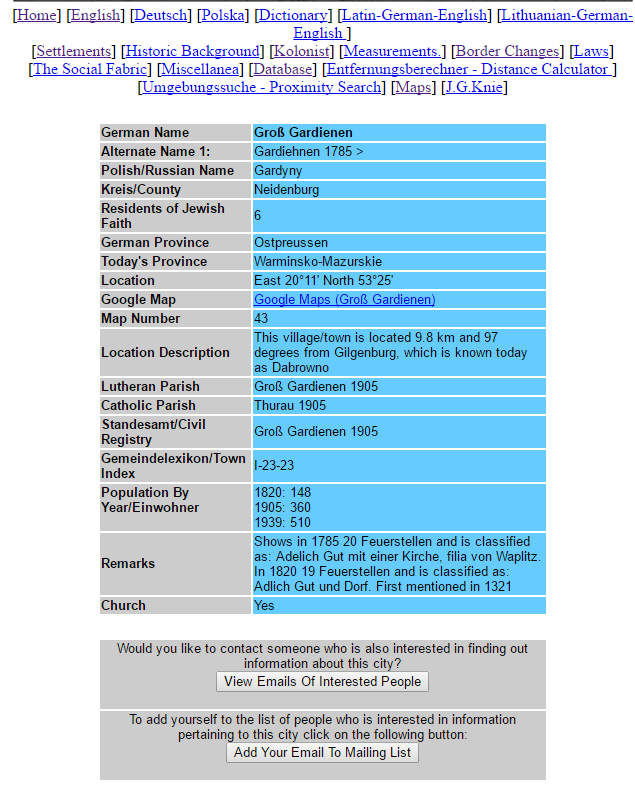
3. Lost Shoebox
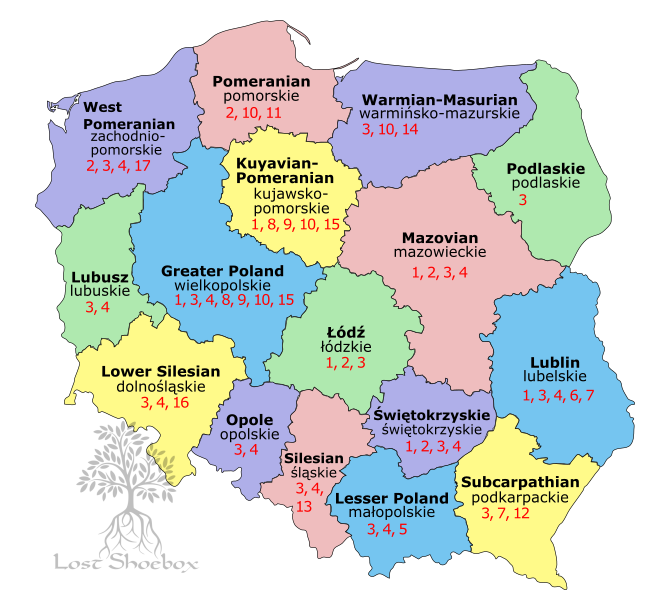
Map of Poland from Lost Shoebox shows where to find online records for each province.
“This website is an index to 17 websites focused on research in Poland. The list of websites corresponds with a map of Poland divided into its various modern provinces. Each number (representing a website) is listed on the map in each province for which it has records. Some websites are listed for nearly every province, while others show up for only one or two. The 17 websites featured on Lost Shoebox include either direct access to digital images, indexes to vital records, or lists of microfilms or other archival holdings.
If we were searching for records for Gross Gardienen or other nearby towns, we know from Kartenmeister that we would need to look in the Warminsko-Mazurskie province. The map shows the numbers 3, 10, and 14.” A corresponding key sends users to the appropriate websites.
“The third website on the list for the province brings us to the website for the Polish State Archive in Olsztyn. There are a plethora of digital images for both Evangelical church records and civil registration records available on this website.”
 Camille Andrus is a Project Manager for Legacy Tree Genealogists, a worldwide genealogy research firm with extensive expertise in breaking through genealogy brick walls. Her expertise includes Germany, Austria, German-speakers from Czech Republic and Switzerland and the Midwest region of the U.S., where many Germans settled.
Camille Andrus is a Project Manager for Legacy Tree Genealogists, a worldwide genealogy research firm with extensive expertise in breaking through genealogy brick walls. Her expertise includes Germany, Austria, German-speakers from Czech Republic and Switzerland and the Midwest region of the U.S., where many Germans settled.
Click here to learn more about Legacy Tree services and its research team
WWI History App in New and Updated Genealogical Collections
A WWI history app for genealogy leads our top picks for this week! History buffs are going to love Remembering WWI, an app that makes your WWI family history come alive. Also in this week’s new and updated genealogical collections, Swedish church records, Canadian marriage records, Pennsylvania naturalizations, and more.
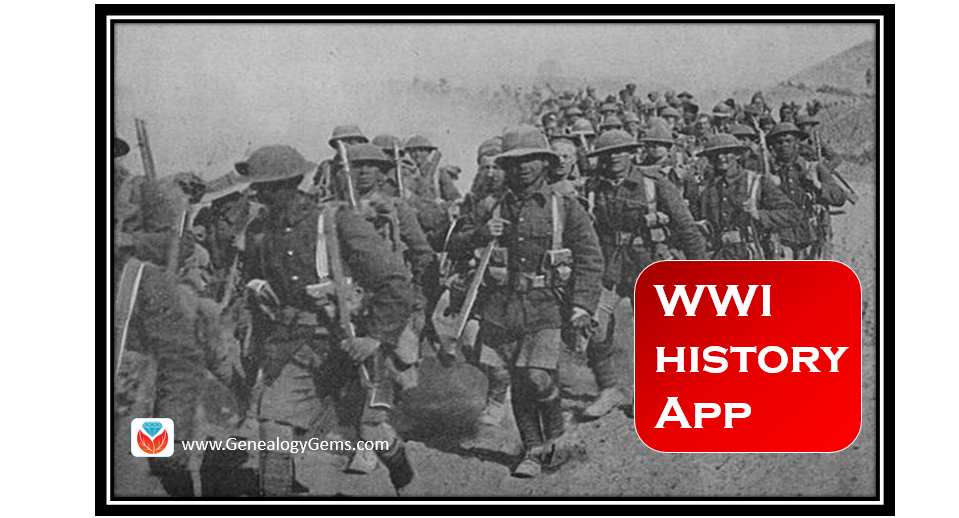
WWI History for Genealogy
The National Archives has launched Remembering WWI, a free app for iPad and Android. It is especially geared for young people, but with an ability to explore, collaborate, and engage with NARA’s extensive collection of WWI photographs, it’s for any history buff. The app commemorates the 100-year anniversary, in April 2017, of the U.S. entry into World War.
It is now available in the iTunes and Google Play stores.
What is even more interesting about this app is how it invites people nationwide to contribute their own stories. You can create your own collections and build and share new narratives around the people, events, and themes you are researching.
Sweden – Norrbotten & Kopparberg – Church Records
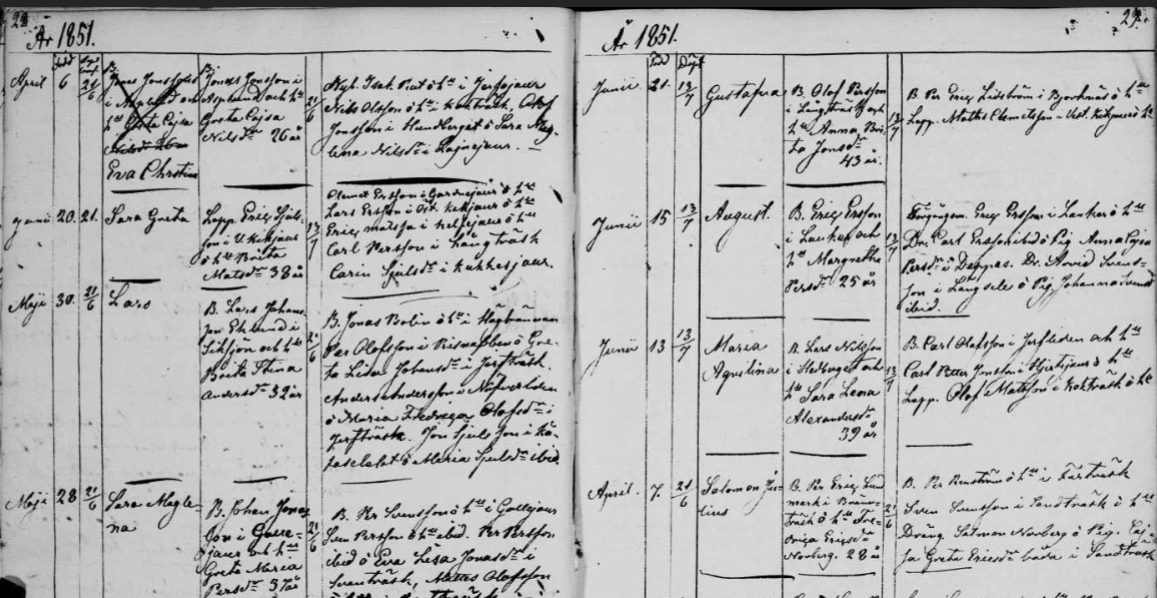
Church Records in Swedish Collections at FamilySearch
Also this week at FamilySearch, Sweden, Norrbotten Church Records, 1612-1923; index 1658-1860 has been updated. You will note the large year span in this collections coverage. Because of this, records will vary. Generally speaking, you will find church records include births, marriages, and deaths and also images to clerical surveys, registers of birth, marriage, death, move-in and move-out lists, confirmations, and church accounts.
Church records are particularly helpful when searching pre-civil registration time frames or when there has been loss or damage to the civil records you need.
In particular, these collections contain household examination records. A household examination record is filled with genealogical data and some other unusual statistics. Information may include:
- The name of the farm, village, or rote (registration area).
- Names of household members including any pigor (female workers) or drängar (male workers)
- Birthplace
- Birth date or age
- A score for catechism knowledge
- Dates of partaking communion
- Dates of participation with the Household Examination
- Moving information
- Death date
- Marriage date
- Disciplinary notes
- Vaccination against smallpox
- Reference to military conscription
Sweden, Kopparberg Church Records, 1604-1900; index 1628-1860 was also updated.
Canada – Ontario – Marriage Registers
The Ontario, County Marriage Registers 1858-1869 at FamilySearch have also been updated. These records contain an index and images of marriages. There are some records that actually date prior to 1858 and after 1869, so be sure to check the collection thoroughly.
These marriage records will generally include the following information:
- Name of groom
- Name and maiden name of bride
- Age of groom and bride at marriage
- Names of groom’s parents and bride’s parents
- Place and date of marriage
- Names of witnesses or possible relatives
United States – New Hampshire – Civil War Service & Pension Records
The New Hampshire, Civil War Service and Pension Records, 1861-1866 are now available at FamilySearch and have been recently updated. The collection includes both an index and images of Civil War enlistment papers, muster rolls of New Hampshire Regiments, and pension records.
The pension records are arranged by town with indexes arranged by name and town. The enlistment papers are arranged by military unit, volume, and year range. The muster rolls are arranged by unit name and folder number.
Pension papers can often be used as substitute records for vital information such as birth, marriage, and death. Additional information may include birth place, occupation, and a physical description.
United States – Alaska – Vital Records
Though a rather small collection with only just over 80,000 records, the Alaska, Vital Records, 1816-1959 may be just what you need. These records include both an index and digital images of birth, marriage, death, and divorce records from Alaska covering the years of 1816-1959. This collection is being published as images become available.
United States – Pennsylvania – Petitions for Naturalization
Pennsylvania, Eastern District Petitions for Naturalization, 1795-1931 at FamilySearch continues to grow. Now up to over 300,000 records, the collection will offer naturalization petitions for the U.S. District Court for the Eastern district of Pennsylvania for the years 1795 to 1931. The records corresponds to NARA publication M1522 part of Record Group 21 Records of District Courts of the United States.
Naturalization papers are an important source of information about an immigrant’s nation of origin, his or her foreign and “Americanized” names, residence, and date of arrival. It is important to note that naturalization changed over time and information will vary greatly.
California in the 1940 Census
Archives.com and other community project partners recently announced the release of the California 1940 census index, and have provided a neat infographic highlighting California in 1940.
I was particularly thrilled to see the searchable California index released because my parents and all my grandparents were in the state , working farms and just a year away from going to war and building ships for the cause.
Enjoy!

